Voyager 1 Sends Clear Data to NASA for the First Time in Five Months
The farthest spacecraft from Earth had been transmitting nonsense since November, but after an engineering tweak, it finally beamed back a report on its health and status
/https://tf-cmsv2-smithsonianmag-media.s3.amazonaws.com/accounts/headshot/Will-Sullivan-photo.png)
Will Sullivan
Daily Correspondent
:focal(2016x1133:2017x1134)/https://tf-cmsv2-smithsonianmag-media.s3.amazonaws.com/filer_public/32/30/3230d19e-cc50-4905-840c-7f3afeb2a0c3/e1-pia26275-voyager-copy-16.jpg)
For the first time in five months, NASA has received usable data from Voyager 1, the farthest spacecraft from Earth.
The aging probe, which has traveled more than 15 billion miles into space, stopped transmitting science and engineering data on November 14. Instead, it sent NASA a nonsensical stream of repetitive binary code . For months, the agency’s engineers undertook a slow process of trial and error, giving the spacecraft various commands and waiting to see how it responded. Thanks to some creative thinking, the team identified a broken chip on the spacecraft and relocated some of the code that was stored there, according to the agency .
NASA is now receiving data about the health and status of Voyager 1’s engineering systems. The next step is to get the spacecraft to start sending science data again.
“Today was a great day for Voyager 1,” Linda Spilker , a Voyager project scientist at NASA’s Jet Propulsion Laboratory (JPL), said in a statement over the weekend, per CNN ’s Ashley Strickland. “We’re back in communication with the spacecraft. And we look forward to getting science data back.”
Hi, it's me. - V1 https://t.co/jgGFBfxIOe — NASA Voyager (@NASAVoyager) April 22, 2024
Voyager 1 and its companion, Voyager 2, separately launched from Earth in 1977. Between the two of them, the probes have studied all four giant planets in the outer solar system—Jupiter, Saturn, Uranus and Neptune—along with 48 of their moons and the planets’ magnetic fields. The spacecraft observed Saturn’s rings in detail and discovered active volcanoes on Jupiter’s moon Io .
Originally designed for a five-year mission within our solar system, both probes are still operational and chugging along through space, far beyond Pluto’s orbit. In 2012, Voyager 1 became the first human-made object to reach interstellar space, the area between stars. The probe is now about eight times farther from the sun than Uranus is on average.
Over the decades, the Voyager spacecraft have transmitted data collected on their travels back to NASA scientists. But in November, Voyager 1 started sending gibberish .
Engineers determined Voyager 1’s issue was with one of three onboard computers, called the flight data system (FDS), NASA said in a December blog post . While the spacecraft was still receiving and executing commands from Earth, the FDS was not communicating properly with a subsystem called the telemetry modulation unit (TMU). The FDS collects science and engineering data and combines it into a package that the TMU transmits back to Earth.
Since Voyager 1 is so far away, testing solutions to its technical issues requires time—it takes 22.5 hours for commands to reach the probe and another 22.5 hours for Voyager 1’s response to come back.
On March 1, engineers sent a command that coaxed Voyager 1 into sending a readout of the FDS memory, NASA said in a March 13 blog post . From that readout, the team confirmed a small part—about 3 percent—of the system’s memory had been corrupted, NASA said in an April 4 update .
The core of the problem turned out to be a faulty chip hosting some software code and part of the FDS memory. NASA doesn’t know what caused the chip to stop working—it could be that a high-energy particle from space collided with it, or the chip might have just run out of steam after almost 50 years spent hurtling through the cosmos.
“It’s the most serious issue we’ve had since I’ve been the project manager, and it’s scary because you lose communication with the spacecraft,” Suzanne Dodd , Voyager project manager at JPL, told Scientific American ’s Nadia Drake in March.
To receive usable data again, the engineers needed to move the affected code somewhere else that wasn’t broken. But no single location in the FDS memory was large enough to hold all of the code, so the engineers divided it into chunks and stored it in multiple places, per NASA .
The team started with moving the code responsible for sending Voyager’s status reports, sending it to its new location in the FDS memory on April 18. They received confirmation that the strategy worked on April 20, when the first data on the spacecraft’s health since November arrived on Earth.
In the next several weeks, the team will relocate the parts of the FDS software that can start returning science data.
Get the latest stories in your inbox every weekday.
/https://tf-cmsv2-smithsonianmag-media.s3.amazonaws.com/accounts/headshot/Will-Sullivan-photo.png)
Will Sullivan | | READ MORE
Will Sullivan is a science writer based in Washington, D.C. His work has appeared in Inside Science and NOVA Next .

NASA’s Voyager 1 Resumes Sending Engineering Updates to Earth

NASA’s Voyager 1 spacecraft is depicted in this artist’s concept traveling through interstellar space, or the space between stars, which it entered in 2012.
After some inventive sleuthing, the mission team can — for the first time in five months — check the health and status of the most distant human-made object in existence.
For the first time since November , NASA’s Voyager 1 spacecraft is returning usable data about the health and status of its onboard engineering systems. The next step is to enable the spacecraft to begin returning science data again. The probe and its twin, Voyager 2, are the only spacecraft to ever fly in interstellar space (the space between stars).
Voyager 1 stopped sending readable science and engineering data back to Earth on Nov. 14, 2023, even though mission controllers could tell the spacecraft was still receiving their commands and otherwise operating normally. In March, the Voyager engineering team at NASA’s Jet Propulsion Laboratory in Southern California confirmed that the issue was tied to one of the spacecraft’s three onboard computers, called the flight data subsystem (FDS). The FDS is responsible for packaging the science and engineering data before it’s sent to Earth.

After receiving data about the health and status of Voyager 1 for the first time in five months, members of the Voyager flight team celebrate in a conference room at NASA’s Jet Propulsion Laboratory on April 20.
The team discovered that a single chip responsible for storing a portion of the FDS memory — including some of the FDS computer’s software code — isn’t working. The loss of that code rendered the science and engineering data unusable. Unable to repair the chip, the team decided to place the affected code elsewhere in the FDS memory. But no single location is large enough to hold the section of code in its entirety.
So they devised a plan to divide the affected code into sections and store those sections in different places in the FDS. To make this plan work, they also needed to adjust those code sections to ensure, for example, that they all still function as a whole. Any references to the location of that code in other parts of the FDS memory needed to be updated as well.
The team started by singling out the code responsible for packaging the spacecraft’s engineering data. They sent it to its new location in the FDS memory on April 18. A radio signal takes about 22 ½ hours to reach Voyager 1, which is over 15 billion miles (24 billion kilometers) from Earth, and another 22 ½ hours for a signal to come back to Earth. When the mission flight team heard back from the spacecraft on April 20, they saw that the modification worked: For the first time in five months, they have been able to check the health and status of the spacecraft.
Get the Latest News from the Final Frontier
During the coming weeks, the team will relocate and adjust the other affected portions of the FDS software. These include the portions that will start returning science data.
Voyager 2 continues to operate normally. Launched over 46 years ago , the twin Voyager spacecraft are the longest-running and most distant spacecraft in history. Before the start of their interstellar exploration, both probes flew by Saturn and Jupiter, and Voyager 2 flew by Uranus and Neptune.
Caltech in Pasadena, California, manages JPL for NASA.
News Media Contact
Calla Cofield
Jet Propulsion Laboratory, Pasadena, Calif.
626-808-2469

- The Contents
- The Making of
- Where Are They Now
- Frequently Asked Questions
- Q & A with Ed Stone
golden record
Where are they now.
- frequently asked questions
- Q&A with Ed Stone
Mission Status
Instrument status.

Where are the Voyagers now?
To learn more about Voyager, zoom in and give the spacecraft a spin. View the full interactive experience at Eyes on the Solar System . Credit: NASA/JPL-Caltech
View Voyager
Space Flight Operations Schedule (SFOS)
SFOS files showing Voyager activity on Deep Space Network (DSN)
2024 Tracking Schedule
2023 tracking schedule, 2022 tracking schedule, 2021 tracking schedule, 2020 tracking schedule, 2019 tracking schedule, 2018 tracking schedule, 2017 tracking schedule, 2016 tracking schedule, 2015 tracking schedule, 2014 tracking schedule, 2013 tracking schedule, 2012 tracking schedule, 2011 tracking schedule, 2010 tracking schedule, 2009 tracking schedule, 2008 tracking schedule, 2007 tracking schedule, 2006 tracking schedule, 2005 tracking schedule, 2004 tracking schedule, 2003 tracking schedule, 2002 tracking schedule, 2001 tracking schedule, 2000 tracking schedule, 1999 tracking schedule, 1998 tracking schedule, 1997 tracking schedule, 1996 tracking schedule, 1995 tracking schedule, 1994 tracking schedule.
Inside NASA's 5-month fight to save the Voyager 1 mission in interstellar space

After working for five months to re-establish communication with the farthest-flung human-made object in existence, NASA announced this week that the Voyager 1 probe had finally phoned home.
For the engineers and scientists who work on NASA’s longest-operating mission in space, it was a moment of joy and intense relief.
“That Saturday morning, we all came in, we’re sitting around boxes of doughnuts and waiting for the data to come back from Voyager,” said Linda Spilker, the project scientist for the Voyager 1 mission at NASA’s Jet Propulsion Laboratory in Pasadena, California. “We knew exactly what time it was going to happen, and it got really quiet and everybody just sat there and they’re looking at the screen.”
When at long last the spacecraft returned the agency’s call, Spilker said the room erupted in celebration.
“There were cheers, people raising their hands,” she said. “And a sense of relief, too — that OK, after all this hard work and going from barely being able to have a signal coming from Voyager to being in communication again, that was a tremendous relief and a great feeling.”

The problem with Voyager 1 was first detected in November . At the time, NASA said it was still in contact with the spacecraft and could see that it was receiving signals from Earth. But what was being relayed back to mission controllers — including science data and information about the health of the probe and its various systems — was garbled and unreadable.
That kicked off a monthslong push to identify what had gone wrong and try to save the Voyager 1 mission.
Spilker said she and her colleagues stayed hopeful and optimistic, but the team faced enormous challenges. For one, engineers were trying to troubleshoot a spacecraft traveling in interstellar space , more than 15 billion miles away — the ultimate long-distance call.
“With Voyager 1, it takes 22 1/2 hours to get the signal up and 22 1/2 hours to get the signal back, so we’d get the commands ready, send them up, and then like two days later, you’d get the answer if it had worked or not,” Spilker said.

The team eventually determined that the issue stemmed from one of the spacecraft’s three onboard computers. Spilker said a hardware failure, perhaps as a result of age or because it was hit by radiation, likely messed up a small section of code in the memory of the computer. The glitch meant Voyager 1 was unable to send coherent updates about its health and science observations.
NASA engineers determined that they would not be able to repair the chip where the mangled software is stored. And the bad code was also too large for Voyager 1's computer to store both it and any newly uploaded instructions. Because the technology aboard Voyager 1 dates back to the 1960s and 1970s, the computer’s memory pales in comparison to any modern smartphone. Spilker said it’s roughly equivalent to the amount of memory in an electronic car key.
The team found a workaround, however: They could divide up the code into smaller parts and store them in different areas of the computer’s memory. Then, they could reprogram the section that needed fixing while ensuring that the entire system still worked cohesively.
That was a feat, because the longevity of the Voyager mission means there are no working test beds or simulators here on Earth to test the new bits of code before they are sent to the spacecraft.
“There were three different people looking through line by line of the patch of the code we were going to send up, looking for anything that they had missed,” Spilker said. “And so it was sort of an eyes-only check of the software that we sent up.”
The hard work paid off.
NASA reported the happy development Monday, writing in a post on X : “Sounding a little more like yourself, #Voyager1.” The spacecraft’s own social media account responded , saying, “Hi, it’s me.”
So far, the team has determined that Voyager 1 is healthy and operating normally. Spilker said the probe’s scientific instruments are on and appear to be working, but it will take some time for Voyager 1 to resume sending back science data.
Voyager 1 and its twin, the Voyager 2 probe, each launched in 1977 on missions to study the outer solar system. As it sped through the cosmos, Voyager 1 flew by Jupiter and Saturn, studying the planets’ moons up close and snapping images along the way.
Voyager 2, which is 12.6 billion miles away, had close encounters with Jupiter, Saturn, Uranus and Neptune and continues to operate as normal.
In 2012, Voyager 1 ventured beyond the solar system , becoming the first human-made object to enter interstellar space, or the space between stars. Voyager 2 followed suit in 2018.
Spilker, who first began working on the Voyager missions when she graduated college in 1977, said the missions could last into the 2030s. Eventually, though, the probes will run out of power or their components will simply be too old to continue operating.
Spilker said it will be tough to finally close out the missions someday, but Voyager 1 and 2 will live on as “our silent ambassadors.”
Both probes carry time capsules with them — messages on gold-plated copper disks that are collectively known as The Golden Record . The disks contain images and sounds that represent life on Earth and humanity’s culture, including snippets of music, animal sounds, laughter and recorded greetings in different languages. The idea is for the probes to carry the messages until they are possibly found by spacefarers in the distant future.
“Maybe in 40,000 years or so, they will be getting relatively close to another star,” Spilker said, “and they could be found at that point.”
Denise Chow is a reporter for NBC News Science focused on general science and climate change.

As an affiliate of PAM Health, PAM Voyages Behavioral Health benefits from the proven track record of PAM’s national system of nearly 100 long-term acute care hospitals, medical rehabilitation hospitals, and outpatient clinics. Our innovative behavioral healthcare hospitals feature a unique model of multidisciplinary mental health and substance abuse care customized to each community we serve.
Guiding your voyage to wellness:
Throughout the communities we serve, PAM Voyages Behavioral Health offers hope and acts as a catalyst for achieving an optimal quality of life by:
- Focusing on putting the patient first and providing high-quality care.
- Providing comprehensive, individualized treatment including; group therapy, recreational therapy, family therapy, and specialized chemical dependency.
- Returning each patient to his or her highest possible functional status
OUR MISSION
PAM Voyages Behavioral Health is committed to providing high-quality patient care and outstanding customer service, coupled with loyal, dedicated, and highly trained staff, to be the most trusted source for behavioral health in every community we serve.
The PAM Voyages Behavioral Health organization builds upon the history of PAM Health as a respected provider of quality healthcare services by continuing to develop an environment that fosters meaningful behavioral health improvement and recovery.
It takes about 11 years for most people to get treatment after experiencing mental health symptoms.
Seek help sooner versus later..
The purpose of our “We Care” program is to make sure that we are providing the very best care for our patients.
Ready to take next step?
We can help.
Voyager Therapeutics signs $30m gene therapy licensing deal with Pfizer
The cambridge biotech is focused on making the delivery of treatments more efficient..

Less than five months after the departure of its chief executive and chief medical officer amid a strategic shift, Cambridge-based Voyager Therapeutics has announced a licensing partnership with Pfizer.
The deal reinforces the biotech’s decision to dedicate more of its resources to proprietary technology that aims to overcome some challenges associated with developing and delivering gene therapies to patients.
Shares in Voyager closed up about 57 percent on Wednesday at $3.87.
Voyager is focused on finding and engineering adeno-associated virus capsids, which are shells that carry the genetic material used in gene therapies. The goal is to create a long-lasting medicine that could be administered through a single dose. The New York drug giant is interested in licensing the technology for its programs in neurologic and cardiovascular diseases.
Advertisement
As part of the deal, Voyager will receive $30 million upfront and up to $600 million more if the partnership meets certain development, regulatory, and commercial goals. The companies didn’t disclose which diseases Pfizer plans to target.
Before its strategic change, Voyager had inked deals with pharmaceutical companies Sanofi Genzyme, AbbVie, and Neurocrine Biosciences that were potentially worth billions of dollars. But AbbVie opted out of its partnership last year after pouring nearly $135 million into research, and in February Neurocrine terminated the portion of its deal focused on Parkinson’s disease, following safety concerns raised by the Food and Drug Administration during clinical trials. Sanofi also has backed out of deals with Voyager.
Founded in 2014 by Boston venture capital firm Third Rock Ventures, Voyager employs about 180 people in the US, according to its latest annual report.
The Voyager-Pfizer deal is one of several local gene therapy partnerships announced this year, including one between Biogen and Ginkgo Bioworks , and another involving ElevateBio and Boston Children’s Hospital .
Anissa Gardizy can be reached at [email protected] . Follow her on Twitter @anissagardizy8 and on Instagram @anissagardizy.journalism .

A Top Paying Travel Nurse Agency
We'll find our travel nurses the highest pay rates nationwide, why voyage healthcare.
When you travel with Voyage Healthcare, you become a part of our family! Discover why our travelers love working with us. Here are some of the benefits you get when you work as a RN for us:
- Industry Leading Pay Rates for RNs
- Dedicated Recruiter to Search Roles for You
- Free, Same Day Health & Life Insurance
- Housing, Licensure & Certification Reimbursements
- 100% 401k Match on Day One
- 30+ Years of Industry Experience
Register Today to Start Your Travel Adventure!
" (Required) " indicates required fields
Disciplines Accepted

From specialties ICU to L&D, we have opportunities for all sorts of travel nurses nationwide!

LPN/LVN? We'll help you find your dream job from our thousands of travel opportunities.

Allied Health
Are you ready for flexibile Allied Health opportunities that fit your lifestyle? Look no further than Voyage!

Housing Resources
Everything you need to help find housing for your next assignment.

Mobile Job Alerts
The latest jobs, sent right to your phone. Text “Join” to 33163, or subscribe here to get started.

Discover a New City
Ready to see and change the world? Find your next job.
What Our Nurses Say

Joining the Voyage Healthcare team has greatly enriched my life. My recruiter, Kavin, made me realize my worth. I am now living my dream by working as a travel nurse. Voyage Healthcare has been with me every step of the way and can't imagine working for any other company.

Brooks and the rest of the voyage team have taken excellent care of me ever since I started working with them. They are all friendly, efficient, trustworthy, and approachable.

Voyage and Brooks Mckenna have been amazing. Brooks has been the best recruiter and helped me through any situation you can think of. He’s very personable and voyage has been there every step of the way. Anyone looking to take the jump in travel nursing I highly recommend Brooks and the voyage staff.

Nicholas B.
Kim is the best of the best! She is always there for you and will always resolve any issues you might have!

Top Paying Travel Nurse Agency
Finding top travel opportunities that fit your needs shouldn’t be time-consuming or stressful. That’s why, we match you with a personalized recruiter that knows the market and has the tools to find you the best pay rates for nurses at the best facilities across the country.
At Voyage Healthcare, we make finding new, lucrative travel assignments easy! We specialize in helping nurses like you find the medical facilitiy that fits your needs, and empower you to focus on what you do best, serving your patients!

Meet the team that’s ready to help you see and change the world.
Each of the staffing professionals on our team have years of experience as executives and recruiters at some of the largest firms in the U.S. But there was one common theme at every place we worked: we felt there was a better way to do healthcare staffing.
In 1999, we put our ideals into action, and started Voyage Healthcare in Omaha, Nebraska. After outgrowing our previous office (and in search of better weather), we relocated to our present-day headquarters in Orlando, Florida.
Today, we’ve blossomed into one of the fastest growing agencies , but despite our humble beginnings, we’ve remained a company that cares about your needs and treats you like family. And at Voyage Healthcare, that’s what we do best, treat you like family. That’s fact alone makes us your unfair advantage in healthcare staffing! You owe it to yourself to experience the Voyage Healthcare difference. Inquire today…we’ll be more than glad to have you!

Follow Us On Social
Keep up with our latest travel nurse tips and tricks by liking us on Facebook and following us on Twitter, YouTube and LinkedIn.
Florida Location
4566 Orange Blvd., Suite 1012 Sanford, Florida 32771
Colorado Location
2154 East Commons Av. Suite 2400 Centennial, Colorado 80122
Phone: 800.798.6035 Fax: 888.235.6035 Email: [email protected]
© 2023 Voyage Solutions. All Rights Reserved.
Due to an increase of whooping cough in the area we are asking patients visiting the surgery who have a persistent cough, to please wear a face mask.
Just Think 111 Online First
Visit 111.nhs.uk or call nhs 111.
When the situation is not life threatening and:
- if you think you need to go to hospital
- if you don’t know the most suitable place to go or call
- if you don’t have a GP to call or if your GP Practice is closed
- if you need advice or reassurance about what to do
Quick Links
Featured news, whooping cough.
For m ore information about whooping cough, please visit https://www.nhs.uk/conditions/whooping-cough/
Health & Wellbeing
Good Sleep Matters
Find the support you need here
Recommended Apps
Get u better.

Practice Information
Reception enquiries.
You can get help with a wide variety of clinical and administrative requests through our website without the need to call or visit the practice.
We strongly encourage our patients to use online services where possible. This helps us to operate more efficiently and deliver a better service to our patients.
Get Help With
- arrow_forward Sick / Fit Notes
- arrow_forward Referrals
- arrow_forward Test Results
- arrow_forward Medical Reports
Appointments
- arrow_forward Consult Online
- arrow_forward Book An Appointment
- arrow_forward Cancel An Appointment
Keep Us Updated
- arrow_forward Change Of Personal Details
- arrow_forward Tell Us If You Are A Carer
- arrow_forward Nhs Digital Data Opt Out
- arrow_forward Update Clinical Record
New Patients
- arrow_forward Join The Practice
- arrow_forward Register For Online Services
- arrow_forward Friends & Family
- arrow_forward Complaint
- The Healthy Voyager Travel Show
- The Healthy Voyager’s Global Kitchen
- The Healthy Voyager’s TV Guest Appearances
- Healthy Voyager Radio
- Dressings & Sauces
- Kid Approved
- Soups & Salads
- Latin America
- Middle East
- Entertainment
- Fashion & Beauty
- Healthy Voyager Approved
- Product Reviews
- Health & Beauty News
- Mind + Body
- Relationship Corner
- Weight Loss
- Women’s Health
- About The Healthy Voyager
- Work With Me
- Disclosure and Privacy Policy
- Entrepreneurial and Business Coaching
- Travel Industry Consulting
- Restaurant, Bar and Food Service Consulting
- Wellness Coaching
- Financial Coaching
- Healthy Voyager Merchandise
- The Healthy Voyager’s Apothecary
- The Healthy Voyager’s Trunk Clothing Rental
- When Cris Met Kringle
- Travel Credit Card Referral Bonuses

The Westin Puerto Vallarta Resort and Spa: A Slice of Paradise that Nurtures Body and Soul
- May 13, 2024

From Zen Gardens to Anime Dreams: Japan’s Icons on Tours
- May 12, 2024

Discover the ultimate experience of Spa at Tryall, Jamaica
- May 11, 2024
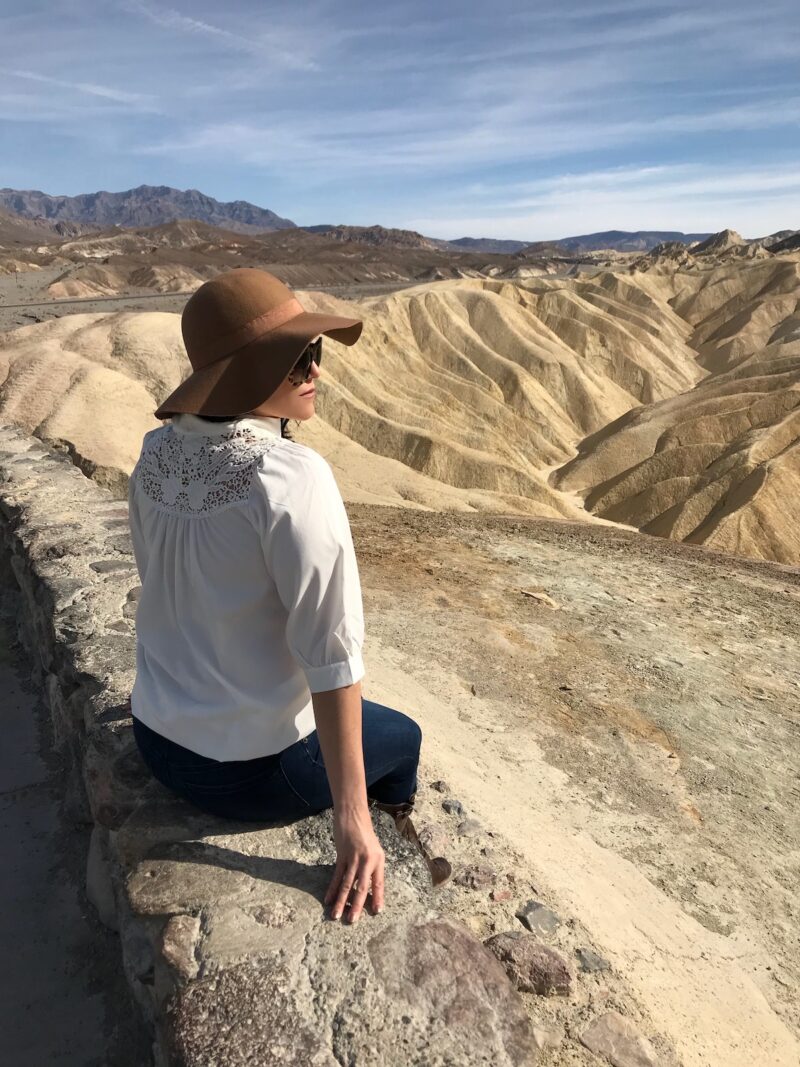
When is the best time of year to visit America’s Death Valley?
- May 10, 2024

The Healthy Voyager Amsterdam
- April 15, 2024

What Is Sicily Known For?
- April 14, 2024

Memorial Day Meals

Mother’s Day Menu
- May 1, 2024

Mocha Latte Protein Breakfast Cake
- April 20, 2024

Easter Basket of Recipes
- March 18, 2024

- March 14, 2024

Areas of The Body That Can Give Away Your Age And What To Do About It

Keeping Your Hearing Past 70: 4 Things You Should Do Today

Taking Food and Drink When Traveling: Tips for a Smooth Journey

Beyond Trauma: How PTSD Can Affect Your Attention and Memory

Effective Work-Life Balance: Tips for Achieving Harmony

Finding the Right Therapist: A Guide for Better Mental Health

Input your search keywords and press Enter.
Privacy Overview
A 'shout' across interstellar space restores contact between Voyager 2 craft and NASA

After weeks of giving Earth the silent treatment , NASA's Voyager 2 spacecraft is once again communicating with mission control from billions of miles away.
All it took was for the ground team to send an interstellar "shout" across more than 12.3 billion miles instructing the historic probe launched in the 1970s to explore the far reaches of space to turn its antenna back to Earth.
Easy enough, right? Not so much.
NASA’s Jet Propulsion Laboratory wasn't even confident the command would be capable of reaching the wayward probe across the expansive solar system. Failure meant that the space agency would have been waiting until mid-October for Voyager 2 to automatically reorient itself after NASA lost contact with the 46-year-old spacecraft last month.
UFO hearing: Witnesses call for increased military transparency on UFOs during hearing
The array of giant radio network antennas known as the Deep Space Network detected a faint signal last week from Voyager 2, which on July 21 had inadvertently tilted its antenna a mere 2 degrees away from Earth. Though the signal was not strong enough for any data to be extracted, the faint "heartbeat" was enough to give NASA hope that the spacecraft was still operational.
In a Hail Mary effort, a Deep Space Network radio dish in Canberra, Australia sent out a message it hoped would somehow reach the craft and command it to correct its antenna orientation.
It took 18 and-a-half hours for the command to reach Voyager 2, and 37 hours total for mission controllers to know whether it was successful. But after what must have been dozens of tense hours, the team received science and telemetry data from Voyager 2 around 12:30 a.m. on Friday, indicating the craft remains operational and on its expected trajectory.
"NASA has reestablished full communications with Voyager 2," JPL announced , saying that the antenna has realigned with Earth.
Where is Voyager 2?
Voyager 2, which is nearly 46 years into its mission, is roughly 12.4 billion miles from Earth after leaving the heliosphere — the shield that protects the planets from interstellar radiation — five years ago, according to NASA.
The agency provides an interactive diagram tracking Voyager 2's path outside the solar system.
Historic probes launched in the 1970s
Voyager 2 was launched into space in 1977 from Cape Canaveral, Florida with the mission of exploring the outer solar system . Its twin probe, Voyager 1, launched two weeks later and at 15 billion miles away, has the distinction of being the farthest human-made object from Earth .
In 2012, Voyager 1 was the first spacecraft to reach interstellar space , followed in 2018 by Voyager 2.
Voyager 1's communications were not interrupted when a routine command sent its twin probe pointing in the wrong direction last month, disrupting it ability to receive commands or transmit data back to Earth.
Had NASA not reestablished contact, it wouldn't have been until Oct. 15 that Voyager 2 would have automatically repositioned its antenna to ensure it was pointed at its home planet.
'Internet apocalypse': How NASA's solar-storm studies could help save the web
Should they encounter extraterrestrial life, both Voyager 1 and 2 carry the famous " golden record ," functioning both as a time capsule and friendly Earthling greeting. The phonograph record — a 12-inch gold-plated copper disk — contains music, languages and sounds representative of Earth's various cultures and eras.
Eric Lagatta covers breaking and trending news for USA TODAY. Reach him at [email protected].

Voyager doses first patient with anti-tau antibody in Alzheimer’s trial
V oyager Therapeutics has dosed the first patient in a Phase Ia single-ascending dose study of its investigational anti-tau antibody VY-TAU01 for patients with Alzheimer’s disease.
The trial will be a randomised, double-blind, placebo-controlled study evaluating the safety and pharmacokinetics of VY-TAU01 in 48 healthy adults. Patients will be randomised to receive intravenously delivered candidate or a placebo. The company plans to initiate a Phase Ib multiple-ascending dose study in 2025, following data from the Phase Ia trial.
The study is indicated to produce initial tau positron emission tomography (PET) imaging data in the second half of 2026. This will indicate if VY-TAU01 can slow the spread of pathological tau in the brain, according to the US-based biotech. Tau proteins help stabilise the structure of neurons, but in Alzheimer’s, they become tangled, disrupting cell function. These tangles are a hallmark of Alzheimer’s and are thought to correlate with the severity of cognitive decline.
The only approved drug that slows Alzheimer’s disease progression and cognitive and functional decline is Biogen and Eisai’s Leqembi (lecanemab). Leqembi targets the amyloid protein pathway, another marker of Alzheimer’s. Anti-tau antibodies have not had much success to date, with Eli Lilly halting the development of zagotenemab after a Phase II trial with the the monoclonal antibody missed its primary endpoint in 2021.
VY-TAU01 is a vectorised version of an anti-tau monoclonal antibody. Voyager has several other candidates in the pipeline, many of which are developed using its TRACER technology. The discovery platform allows for the discovery of AAV capsids which can cross the blood-brain barrier and target the central nervous system.
Pharma giant Novartis signed a collaboration and capsid license agreement with Voyager in January 2024 worth $1.3bn. The pair teamed up to develop gene therapies for Huntington’s disease and spinal muscular atrophy (SMA). This partnership builds on a previous collaboration in 2022, where Novartis could exercise options to license three adeno-associated virus (AAV) capsids for potential use in gene therapies for three undisclosed neurological disease targets.
In the announcement accompanying the trial initiation, Voyager’s chief medical officer Toby Ferguson said: “The initiation of clinical development of VY-TAU01 for the treatment of Alzheimer’s disease is an important milestone for Voyager; it demonstrates the executional abilities of our neurology drug development team, which will be central to our advancement of three wholly owned and partnered neurology gene therapies towards IND filings next year.”
A GlobalData report predicts that the global Alzheimer’s market will be worth $15.9bn in 2030.
GlobalData is the parent company of Clinical Trials Arena.
"Voyager doses first patient with anti-tau antibody in Alzheimer’s trial" was originally created and published by Clinical Trials Arena , a GlobalData owned brand.
The information on this site has been included in good faith for general informational purposes only. It is not intended to amount to advice on which you should rely, and we give no representation, warranty or guarantee, whether express or implied as to its accuracy or completeness. You must obtain professional or specialist advice before taking, or refraining from, any action on the basis of the content on our site.

- Skip to main content
- Keyboard shortcuts for audio player
NASA's Voyager 1 spacecraft is talking nonsense. Its friends on Earth are worried

Nell Greenfieldboyce

This artist's impression shows one of the Voyager spacecraft moving through the darkness of space. NASA/JPL-Caltech hide caption
This artist's impression shows one of the Voyager spacecraft moving through the darkness of space.
The last time Stamatios "Tom" Krimigis saw the Voyager 1 space probe in person, it was the summer of 1977, just before it launched from Cape Canaveral, Florida.
Now Voyager 1 is over 15 billion miles away, beyond what many consider to be the edge of the solar system. Yet the on-board instrument Krimigis is in charge of is still going strong.
"I am the most surprised person in the world," says Krimigis — after all, the spacecraft's original mission to Jupiter and Saturn was only supposed to last about four years.
These days, though, he's also feeling another emotion when he thinks of Voyager 1.
"Frankly, I'm very worried," he says.
Ever since mid-November, the Voyager 1 spacecraft has been sending messages back to Earth that don't make any sense. It's as if the aging spacecraft has suffered some kind of stroke that's interfering with its ability to speak.
"It basically stopped talking to us in a coherent manner," says Suzanne Dodd of NASA's Jet Propulsion Laboratory, who has been the project manager for the Voyager interstellar mission since 2010. "It's a serious problem."
Instead of sending messages home in binary code, Voyager 1 is now just sending back alternating 1s and 0s. Dodd's team has tried the usual tricks to reset things — with no luck.
It looks like there's a problem with the onboard computer that takes data and packages it up to send back home. All of this computer technology is primitive compared to, say, the key fob that unlocks your car, says Dodd.
"The button you press to open the door of your car, that has more compute power than the Voyager spacecrafts do," she says. "It's remarkable that they keep flying, and that they've flown for 46-plus years."

Each of the Voyager probes carries an American flag and a copy of a golden record that can play greetings in many languages. NASA/JPL-Caltech hide caption
Each of the Voyager probes carries an American flag and a copy of a golden record that can play greetings in many languages.
Voyager 1 and its twin, Voyager 2, have outlasted many of those who designed and built them. So to try to fix Voyager 1's current woes, the dozen or so people on Dodd's team have had to pore over yellowed documents and old mimeographs.
"They're doing a lot of work to try and get into the heads of the original developers and figure out why they designed something the way they did and what we could possibly try that might give us some answers to what's going wrong with the spacecraft," says Dodd.
She says that they do have a list of possible fixes. As time goes on, they'll likely start sending commands to Voyager 1 that are more bold and risky.
"The things that we will do going forward are probably more challenging in the sense that you can't tell exactly if it's going to execute correctly — or if you're going to maybe do something you didn't want to do, inadvertently," says Dodd.
Linda Spilker , who serves as the Voyager mission's project scientist at NASA's Jet Propulsion Laboratory, says that when she comes to work she sees "all of these circuit diagrams up on the wall with sticky notes attached. And these people are just having a great time trying to troubleshoot, you know, the 60's and 70's technology."
"I'm cautiously optimistic," she says. "There's a lot of creativity there."
Still, this is a painstaking process that could take weeks, or even months. Voyager 1 is so distant, it takes almost a whole day for a signal to travel out there, and then a whole day for its response to return.
"We'll keep trying," says Dodd, "and it won't be quick."
In the meantime, Voyager's 1 discombobulation is a bummer for researchers like Stella Ocker , an astronomer with Caltech and the Carnegie Observatories
"We haven't been getting science data since this anomaly started," says Ocker, "and what that means is that we don't know what the environment that the spacecraft is traveling through looks like."

After 35 Years, Voyager Nears Edge Of Solar System
That interstellar environment isn't just empty darkness, she says. It contains stuff like gas, dust, and cosmic rays. Only the twin Voyager probes are far out enough to sample this cosmic stew.
"The science that I'm really interested in doing is actually only possible with Voyager 1," says Ocker, because Voyager 2 — despite being generally healthy for its advanced age — can't take the particular measurements she needs for her research.
Even if NASA's experts and consultants somehow come up with a miraculous plan that can get Voyager 1 back to normal, its time is running out.
The two Voyager probes are powered by plutonium, but that power system will eventually run out of juice. Mission managers have turned off heaters and taken other measures to conserve power and extend the Voyager probes' lifespan.
"My motto for a long time was 50 years or bust," says Krimigis with a laugh, "but we're sort of approaching that."
In a couple of years, the ebbing power supply will force managers to start turning off science instruments, one by one. The very last instrument might keep going until around 2030 or so.
When the power runs out and the probes are lifeless, Krimigis says both of these legendary space probes will basically become "space junk."
"It pains me to say that," he says. While Krimigis has participated in space missions to every planet, he says the Voyager program has a special place in his heart.
Spilker points out that each spacecraft will keep moving outward, carrying its copy of a golden record that has recorded greetings in many languages, along with the sounds of Earth.
"The science mission will end. But a part of Voyager and a part of us will continue on in the space between the stars," says Spilker, noting that the golden records "may even outlast humanity as we know it."
Krimigis, though, doubts that any alien will ever stumble across a Voyager probe and have a listen.
"Space is empty," he says, "and the probability of Voyager ever running into a planet is probably slim to none."
It will take about 40,000 years for Voyager 1 to approach another star; it will come within 1.7 light years of what NASA calls "an obscure star in the constellation Ursa Minor" — also known as the Little Dipper.

If NASA greenlights this interstellar mission, it could last 100 years
Knowing that the Voyager probes are running out of time, scientists have been drawing up plans for a new mission that, if funded and launched by NASA, would send another probe even farther out into the space between stars.
"If it happens, it would launch in the 2030s," says Ocker, "and it would reach twice as far as Voyager 1 in just 50 years."
- space exploration
- space science
- Today's news
- Reviews and deals
- Climate change
- 2024 election
- Fall allergies
- Health news
- Mental health
- Sexual health
- Family health
- So mini ways
- Unapologetically
- Buying guides
Entertainment
- How to Watch
- My Portfolio
- Latest News
- Stock Market
- Premium News
- Biden Economy
- EV Deep Dive
- Stocks: Most Actives
- Stocks: Gainers
- Stocks: Losers
- Trending Tickers
- World Indices
- US Treasury Bonds
- Top Mutual Funds
- Highest Open Interest
- Highest Implied Volatility
- Stock Comparison
- Advanced Charts
- Currency Converter
- Basic Materials
- Communication Services
- Consumer Cyclical
- Consumer Defensive
- Financial Services
- Industrials
- Real Estate
- Mutual Funds
- Credit cards
- Balance Transfer Cards
- Cash-back Cards
- Rewards Cards
- Travel Cards
- Personal Loans
- Student Loans
- Car Insurance
- Morning Brief
- Market Domination
- Market Domination Overtime
- Opening Bid
- Stocks in Translation
- Lead This Way
- Good Buy or Goodbye?
- Fantasy football
- Pro Pick 'Em
- College Pick 'Em
- Fantasy baseball
- Fantasy hockey
- Fantasy basketball
- Download the app
- Daily fantasy
- Scores and schedules
- GameChannel
- World Baseball Classic
- Premier League
- CONCACAF League
- Champions League
- Motorsports
- Horse racing
- Newsletters
New on Yahoo
- Privacy Dashboard

Yahoo Finance
Voyager therapeutics announces first participants dosed in single ascending dose trial of vy-tau01 for the treatment of alzheimer’s disease.
LEXINGTON, Mass., May 16, 2024 (GLOBE NEWSWIRE) -- Voyager Therapeutics, Inc. (Nasdaq: VYGR), a biotechnology company dedicated to advancing neurogenetic medicines, today announced that the first participants were dosed in a Phase 1a single ascending dose (SAD) trial of VY-TAU01, an investigational anti-tau antibody developed to inhibit the spread of pathological tau in Alzheimer’s disease.
The objective of the randomized, double-blind, placebo-controlled, SAD trial is to evaluate the safety and pharmacokinetics of VY-TAU01 in healthy adult volunteers. The study is being conducted at a single site in the United States and is expected to enroll approximately 48 patients in multiple cohorts. Voyager anticipates that the data from the SAD trial will inform the design of a Phase 1b multiple ascending dose (MAD) trial in patients with early Alzheimer’s disease, which Voyager expects to initiate in 2025. The MAD study has the potential to generate initial tau PET imaging data in the second half of 2026, which may indicate if VY-TAU01 can slow the spread of pathological tau in the brain.
“The initiation of clinical development of VY-TAU01 for the treatment of Alzheimer’s disease is an important milestone for Voyager; it demonstrates the executional abilities of our neurology drug development team, which will be central to our advancement of three wholly-owned and partnered neurology gene therapies towards IND filings next year,” said Toby Ferguson, M.D., Ph.D., Chief Medical Officer of Voyager Therapeutics. “Alzheimer’s disease remains an area with tremendous unmet patient need, despite recent advances. We are encouraged by our preclinical data demonstrating the ability of VY-TAU01 to significantly slow tau spreading, and we look forward to evaluating the therapeutic potential of VY-TAU01 in the clinic.”
About VY-TAU01 VY-TAU01 is an IV-administered, recombinant, humanized IgG4 monoclonal antibody developed to inhibit the spread of pathological tau, which is closely correlated with disease progression and cognitive decline in Alzheimer’s disease. In contrast to previous N-terminal directed anti-tau antibodies that did not show efficacy in clinical studies, VY-TAU01 targets a distinct C-terminal epitope of tau and has demonstrated robust in vivo inhibition of the spread of pathological tau in a preclinical model. Additional preclinical studies have demonstrated that VY-TAU01 was well-tolerated and demonstrated a favorable pharmacokinetic profile following IV administration.
About Alzheimer’s Disease Alzheimer’s disease is a progressive neurodegenerative disease estimated to affect 6 million people in the U.S. i and up to 416 million people globally ii . The disease causes memory loss and may escalate to decreased independence, communication challenges, behavioral disorders such as paranoia and anxiety, and lack of physical control iii . In 2023, the total cost of caring for people living with Alzheimer’s and other dementias in the U.S. is estimated at $345 billion iv .
About Voyager Therapeutics Voyager Therapeutics, Inc. (Nasdaq: VYGR) is a biotechnology company dedicated to leveraging the power of human genetics to modify the course of – and ultimately cure – neurological diseases. Our pipeline includes programs for Alzheimer’s disease, amyotrophic lateral sclerosis (ALS), Parkinson’s disease, and multiple other diseases of the central nervous system. Many of our programs are derived from our TRACER™ AAV capsid discovery platform, which we have used to generate novel capsids and identify associated receptors to potentially enable high brain penetration with genetic medicines following intravenous dosing. Some of our programs are wholly owned, and some are advancing with partners including Alexion, AstraZeneca Rare Disease; Novartis Pharma AG; Neurocrine Biosciences, Inc.; and Sangamo Therapeutics, Inc. For more information, visit www.voyagertherapeutics.com .
Voyager Therapeutics® is a registered trademark, and TRACER™ is a trademark, of Voyager Therapeutics, Inc.
Forward-Looking Statements This press release contains forward-looking statements for the purposes of the safe harbor provisions under The Private Securities Litigation Reform Act of 1995 and other federal securities laws. The use of words such as “potential,” “anticipate,” “expect,” “will,” “may,” and other similar expressions are intended to identify forward-looking statements.
For example, all statements Voyager makes regarding Voyager’s ability to advance its AAV-based gene therapy programs and tau antibody program, including expectations for Voyager’s achievement of preclinical and clinical development milestones for its potential development candidates such as IND filings, the initiation of clinical trials, and the generation of clinical data; the potential for clinical data from the SAD trial to inform the design of the Voyager’s anticipated MAD trial; and Voyager’s ability to advance gene therapy product candidates under its partnered programs are forward looking.
All forward-looking statements are based on estimates and assumptions by Voyager’s management that, although Voyager believes such forward-looking statements to be reasonable, are inherently uncertain. All forward-looking statements are subject to risks and uncertainties that may cause actual results to differ materially from those that Voyager expected. Such risks and uncertainties include, among others, the continued development of Voyager’s technology platforms, including Voyager’s TRACER platform and its antibody screening technology; the ability to initiate and conduct preclinical studies in animal models; the development by third parties of capsid identification platforms that may be competitive to Voyager’s TRACER capsid discovery platform; Voyager’s ability to create and protect intellectual property rights associated with the TRACER capsid discovery platform, the capsids identified by the platform, and development candidates for Voyager’s pipeline programs; the initiation, timing, conduct and outcomes of Voyager’s preclinical and clinical studies; the possibility or the timing of Voyager’s receipt of program reimbursement, development or commercialization milestones, option exercise, and other payments under Voyager’s existing licensing or collaboration agreements; the ability of Voyager to negotiate and complete licensing or collaboration agreements with other parties on terms acceptable to Voyager and the third parties; the ability to attract and retain talented directors, employees, and contractors; and the sufficiency of cash resources to fund its operations and pursue its corporate objectives.
These statements are also subject to a number of material risks and uncertainties that are described in Voyager’s most recent Annual Report on Form 10-K filed with the Securities and Exchange Commission. All information in the press release is as of the date of this press release, and any forward-looking statement speaks only as of the date on which it was made. Voyager undertakes no obligation to publicly update or revise this information or any forward-looking statement, whether as a result of new information, future events or otherwise, except as required by law.
Contacts Trista Morrison, NACD.DC, [email protected] Investors: Adam Bero, Ph.D., [email protected] Media: Brooke Shenkin, [email protected]
____________________________
i Alzheimer’s Association. 2023 Alzheimer’s Facts and Figures. Available at: https://www.alz.org/media/Documents/alzheimers-facts-and-figures.pdf . Accessed February 15, 2024. ii Gustavsson A, Norton N, Fast T, et al. Global estimates on the number of persons across the Alzheimer's disease continuum. Alzheimer's Dement . 2023; 19: 658–670. doi: 10.1002/alz.12694. iii Penn Medicine. The 7 Stages of Alzheimer’s Disease. Available at: https://www.pennmedicine.org/updates/blogs/neuroscience-blog/2019/november/stages-of-alzheimers . Accessed February 15, 2024. iv USAgainstAlzheimer’s. The Alzheimer’s Disease Crisis – By the Numbers. Available at: The Alzheimer’s Disease Crisis – By the Numbers | UsAgainstAlzheimer's ( usagainstalzheimers.org ). Accessed: February 15, 2024.
University of South Florida
Main Navigation

Karen Ruiz-Ayala, MPH . (Photo courtesy of Ruiz-Ayala)
The voyage of one COPH alumni through public health
- Liz Bannon, College of Public Health
- May 10, 2024
- Alumni & Development
Originally from Puerto Rico, Karen Ruiz-Ayala, a USF College of Public Health alumna, moved to Spring Hill, Fla. when she was young and discovered her passion for public health through reading.
“I was very interested in medical history and stories. An important introduction to the topic of public health was the book “Deadly” by Julie Chibbaro. It’s a fictionalized story about a young girl working as a lab assistant in New York at the turn of the century investigating a strange illness outbreak that would later be known as the famous Typhoid Mary case.,” she said.
Ruiz-Ayala’s decision to attend the COPH was influenced by its emphasis on research opportunities, notably the COPH Activist Lab , where she served as a student board member.
" Dr. Karen Liller , the director of the Activist Lab, was a big inspiration,” Ruiz-Ayala said. “She made me feel like I could accomplish anything I set my mind to and was a role model for me."
Amidst her academic pursuits, Ruiz-Ayala faced the challenge of adapting to the COVID-19 pandemic. Reflecting on this experience, she shared, "We were sent home just a few weeks into my first semester at USF, and it was surreal learning about public health and its history while living through a pandemic as well.It was one of the best lessons about socioeconomic determinants of health and well-being that I could have ever had.”
Transitioning from academia to practical application, Ruiz-Ayala began her public health career at Hillsborough County Mosquito Management, where she worked as a mosquito control technician. In 2023, Ruiz went on to earn her master of public health, with a concentration in epidemiology from the University of Glasgow, in the United Kingdom.
Currently, Ruiz-Ayala is the public health officer for Carnival Cruise Lines, working onboard the Carnival Paradise.
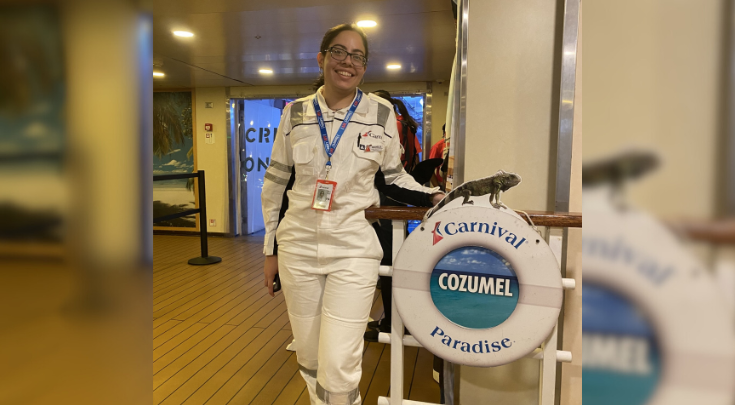
As part of her integrated pest management duties, Ruiz-Ayala waits for ship clearance from local port authorities in order to go outside and check that the rat guard was placed properly to ensure the ship can avoid rodents coming onboard via the mooring lines. (Photo courtesy of Ruiz-Ayala)
In her role, Ruiz-Ayala said she ensures compliance with disease prevention and control measures, including COVID-19 protocols, and participates in outbreak management teams. She also oversees vessel compliance in areas such as sanitation and pest management, conducting audits and inspections to uphold public health standards.
“A passenger once asked me what I do onboard. I started to answer with a generic, ‘I’m the public health officer and my main responsibility is ensuring we prevent any illness outbreaks,’” Ruiz-Ayala said. “But our senior doctor cut in and said ‘She’s like the doctor for the whole boat. When people come to see me for something I can only ensure that individual is healthy, but she ensures the entire boat stays healthy’.”
Ruiz-Ayalya also said she is involved in all departments including management both shipboard and shoreside.
"Effective communication for all departments is key to addressing public health concerns and maintaining a safe environment onboard," she said. "This means that I am involved in recreational and portable water, to the engine room, bridge, deck, housekeeping, food service and integrated pest management, as each one plays a different role in the health and safety of everyone onboard."
Despite the demanding nature of her work, Ruiz-Ayala said she finds fulfillment in the diverse responsibilities of her role.
"From disease prevention and control to vessel sanitation compliance and integrated pest management, I get to experience a wide range of public health practices," she said. "This diversity allows me to continually learn and grow professionally while making a meaningful impact on the health and safety of guests and crew."
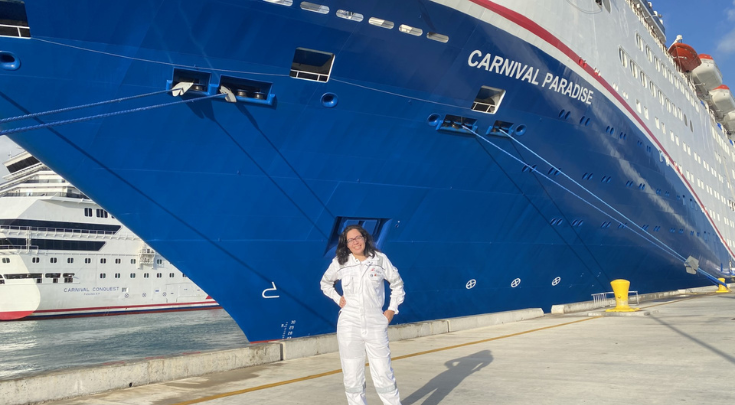
Ruiz-Ayala is in front of the ship Paradise docked in Nassau, Bahamas in April 2024. (Photo courtesy Ruiz-Ayala)
She also pointed to travel as being one of the best perks of this job. “On my current itinerary, I travel in the Caribbean and the Bahamas. Seeing beautiful islands that so many people only dream of visiting in my everyday life is a special memory that I will always have.”
“Public health allows us to look at things from the bigger picture, address systemic issues, implement preventive measures and ultimately improve the overall well-being of communities and populations, making a lasting impact beyond individual health outcomes,” Ruiz-Ayala said. “By understanding the broader factors influencing health, we can create more effective interventions and policies that promote health equity and sustainable change.
In the future, Ruiz Ayala said she would like to transition to working more with integrated pest management. “That was my master’s thesis and one of my specialties with my previous work experience,” she said. “Most public health officers have a specialty such as water, sanitation, medical and mine just happens to be pest management.”
What did you want to be when you grew up? A doctor.
Where can we find you on the weekend? Working. I work 4 months at a time, 10 hours a day, with no days off. I usually don’t know what day of the week it is, only if we are in Bimini or Cozumel.
What is a superpower you would want to have? Teleportation so I could be with the people I love more easily while I’m working onboard.
What is the last book you read? “Done and Dusted” by Lyla Sage.
What is your all-time favorite movie? “Mamma Mia”.
Return to article listing
Karen Ruiz-Ayala
Explore More Categories
- Awards & Honors
- College News
- Community Engagement
- In the Media
- Research & Innovation
- Student Life
- USF SafetyFlorida
About Department News
Welcome to the USF COPH news page. Our marketing and communications team is entrusted with storytelling. Through written stories, photography, video and social media we highlight alumni, faculty, staff and students who are committed to passionately solving problems and creating conditions that allow every person the universal right to health and well-being. These are our stories.
Voyager 1 was in crisis in interstellar space. NASA wouldn’t give up.
NASA engineers spent months doggedly trying to fix a computer on Voyager 1, a spacecraft launched in the 1970s that’s now exploring interstellar space.

For the past six months a team of engineers at NASA’s Jet Propulsion Laboratory has been trying to fix a glitchy computer. Three things make the repair job challenging:
The computer is highly customized and unlike anything on the market today.
It was built in the 1970s.
And it is 15 billion miles away.
The computer is on Voyager 1, the most distant human-made spacecraft ever launched. Far beyond the orbit of Pluto, it is riding point for all humanity as it hurtles through interstellar space.
But on Nov. 14, Voyager 1 suddenly stopped sending any data back to Earth. While it remained in radio contact, the transmission had, as NASA engineers put it, “flatlined.” So began the greatest crisis in the history of the fabled Voyager program.
Voyager 1 and its twin, Voyager 2, launched in 1977 and in the years that followed obtained stunning close-up images of Jupiter and Saturn. Voyager 2 also flew by Uranus and Neptune and is the only spacecraft to have visited those ice giants. The Voyagers blew past the heliopause, where the solar wind abates and interstellar space begins, and continued to send back science data about particles and magnetic fields in a realm never before visited.
The two Voyagers are powered by the radioactive decay of plutonium-238, and in the near future that power source will be too feeble to keep the spacecraft warm and functioning. But for now, they have operational scientific instruments that are sending back otherwise unobtainable data on the composition of space beyond the heliopause.
Fixing Voyager 1 quickly became a priority for NASA, and especially for Jeffrey Mellstrom, who has been at JPL in Pasadena for 35 years and is the chief engineer in the astronomy and physics directorate.
Mellstrom took on the challenge even as he planned for retirement in the spring. In January, Mellstrom told a colleague, “The one thing I’m going to regret is if I retire before we solve Voyager 1’s problem.”
Like kicking a vending machine
After initial attempts to resolve the issue went nowhere, JPL leadership created a “tiger team” made of a multigenerational crew of engineers, some of them veterans of the lab and some born long after the Voyagers launched.
“We didn’t know how to solve this in the beginning because we didn’t know what’s wrong,” said Mellstrom, the team’s leader.
Voyager 1 has three computers. One is the attitude and articulation control system, which makes sure the spacecraft is pointed in the right direction. Another is the command control system, which handles the commands coming from Earth. The third is the flight data subsystem, which takes science and engineering data and packages it for transmission home.
Something had gone wrong somewhere in that trio of computers. Maybe a “cosmic ray” — a particle from deep space — had smashed into a computer chip. Or maybe a piece of hardware just got so old it ceased to work.
“All we had was incoherent data, garbled data,” said Suzanne Dodd, the Voyager project manager since 2010. Dodd has been at JPL for four decades, and in her early years she wrote computer code for Voyager 2’s encounters with Uranus and Neptune. She vividly remembers that first close-up look of Neptune and an image of the ice giant with its huge moon Triton in the background.
“We didn’t know what part of the spacecraft was involved with this,” Dodd said.
So they poked it. They sent commands to Voyager 1, trying to jolt it back to coherence. The team had a list of potential failures and figured that one of the commands might have the equivalent effect of kicking a vending machine.
Here is where the troubleshooting encountered an inviolable obstacle: the speed of light. Even at 186,000 miles per second, a command sent to Voyager 1 would take 22½ hours to arrive. Then the engineers would have to wait another 22½ hours for the spacecraft to send a response.
The planet Earth is kind of a pain, too, because it spins inconveniently on its axis and moves restlessly around the sun. To communicate with distant spacecraft, NASA relies on the Deep Space Network, three arrays of huge radio telescopes in California, Spain and Australia. The idea is that, regardless of Earth’s movement, at least one array can be pointed toward a spacecraft at almost any time.
The tiger team developed a pattern of sending a command on a Friday and waiting for the return signal on Sunday. Some dark days and weeks followed.
“None of those commands that we sent were able to make any discernible difference whatsoever,” said David Cummings, an advanced flight software designer and developer.
In late February, the team sent a series of commands to prod the flight data subsystem to place software in each of 10 different “data modes.” The team waited, hoping for a breakthrough. After two days, Voyager responded — still without data. Engineer Greg Chin circulated a technical chart and summarized the situation: “So, at this time, no joy.”
“It was unbelievably depressing,” Cummings said. “Luckily the story doesn’t end there.”
Cracking the code
Just a day after the “no joy” email, the team felt a surge of optimism.
JPL has specialists in radio transmissions, and they noticed that in some “modes” the return signal from Voyager 1 had been modulated in a pattern consistent with the flight subsystem computer producing data, though not in any normal format. The modulation suggested that the processor was functioning and supported the team’s conjecture that some of the memory had been corrupted.
“That was huge,” Cummings said. “The processor was not dead.”
Painstakingly, the team at last tracked down the origin of the problem: a bad memory chip holding one bit — the smallest unit of binary data — for each of 256 contiguous words of memory.
The flight data subsystem was built with 8K memory, or more exactly 8,192 bytes. (A modern smartphone has something like 6G memory, or 6 billion bytes.)
The engineers came up with a plan: They would move the software to different parts of the flight data subsystem memory. Unfortunately they couldn’t just move the 256 words in a single batch, because there was no place roomy enough for all of it. They had to break it down into pieces. And they’d have to proofread everything. It was tedious, error-prone work.
Cummings called a young JPL flight software engineer named Armen Arslanian: “Do you want to help me relocate Voyager code?”
Arslanian was the right person for the job. Just six years out of college, he knew how to write code for spacecraft, and he knew how to deal with “assembly language,” the coding that underlies the common languages used by programmers today. That’s the language of Voyager’s 1970s-era computers.
“I ended up needing that skill,” Arslanian said.
The JPL teams had documentation from the 1970s describing the function of the software, but often the descriptions were contingent on other information that could not be found. The team also lacked the tools to verify their coding. They had to do everything essentially by hand. It wasn’t like trying to find a needle in a haystack so much as like trying to examine every piece of hay for possible flaws.
The team prioritized the software for the engineering data so that they could fully restore communication with the spacecraft. If that worked, they could fix the science data later.
On April 18, the team sent a package of commands to the spacecraft and then waited. Two days later the spacecraft sent back the first intelligible engineering data in more than five months.
There is more work to be done, but the end is in sight. The engineers are still working on transferring the code that controls the scientific data. But they know how to do this. They found the problem, figured out the workaround and are just grinding through the code transfer.
Mellstrom and Dodd are fully confident that Voyager 1 has been saved. Mellstrom said he can retire without regret.
“The spacecraft is working,” Dodd said. “Go Voyager!”
An earlier version of this story incorrectly said Jeffrey Mellstrom and Suzanne Dodd are married. They are married to other people. This story has been corrected.

This Week In Space podcast: Episode 110 — Voyager 1's Brush with Silence
Saving an Icon With Project Scientist Dr. Linda Spilker
On Episode 110 of This Week In Space , Rod and Tariq talk with Linda Spilker, Voyager project scientist, about the recent rescue of Voyager 1 from beyond the solar system.
The Voyager probes have been transiting space since 1977, and they're still at it 46 years later. But late in 2023, Voyager 1, now 15 billion miles distant, started sending what the flight controllers called "gibberish" back to Earth — uncoordinated ones and zeros and a heartbeat tone. They knew it was still alive, but something had gone wrong.
The small team of software wizards at the Jet Propulsion Laboratory got to work and came up with a workaround... but due to the age of the program, did not have an old enough computer on the ground to test it! They'd have to eyeball the sequence and send it to overwrite existing programming on the spacecraft.
The round-trip radio signal from Earth takes 45 hours... and it was a nail-biter.
Download or subscribe to this show at: https://twit.tv/shows/this-week-in-space . Get episodes ad-free with Club TWiT at https://twit.tv/clubtwit
Space news of the week
- Boeing Delay
- JWST finds exoplanet atmosphere
- I don't see any evidence of aliens.' SpaceX's Elon Musk says Starlink satellites have never dodged UFOs
- Dr. Linda Spilker bio
- Voyager Mission Visual Summary
- NASA -- Voyager Mission Status
Model Falcon 9!

Looking for a telescope to see planets and comets? We recommend the Celestron Astro Fi 102 as the top pick in our best beginner's telescope guide .
Finally, did you know you can launch your own SpaceX rocket? Model rocket maker Estes' stunning scale model of a Falcon 9 rocket that you can pick up now. The launchable model is a detailed recreation of the Falcon 9 and retails for $149.99. You can save 10% by using the code IN-COLLECTSPACE at checkout , courtesy of our partners collectSPACE.com.
About This Week In Space
This Week in Space covers the new space age. Every Friday we take a deep dive into a fascinating topic. What's happening with the new race to the moon and other planets? When will SpaceX really send people to Mars?
Get the Space.com Newsletter
Breaking space news, the latest updates on rocket launches, skywatching events and more!
Join Rod Pyle and Tariq Malik from Space.com as they tackle those questions and more each week on Friday afternoons. You can subscribe today on your favorite podcatcher.
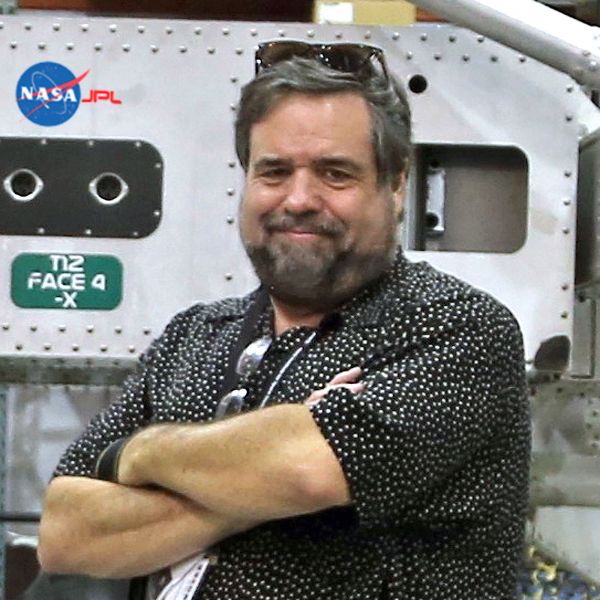
Rod Pyle is an author, journalist, television producer and Editor-in-Chief of Ad Astra magazine . He has written 18 books on space history, exploration, and development, including Space 2.0 , Innovation the NASA Way , Interplanetary Robots , Blueprint for a Battlestar , Amazing Stories of the Space Age , First On the Moon , and Destination Mars
In a previous life, Rod produced numerous documentaries and short films for The History Channel, Discovery Communications, and Disney. He also worked in visual effects on Star Trek: Deep Space Nine and the Battlestar Galactica reboot, as well as various sci-fi TV pilots. His most recent TV credit was with the NatGeo documentary on Tom Wolfe's iconic book The Right Stuff .
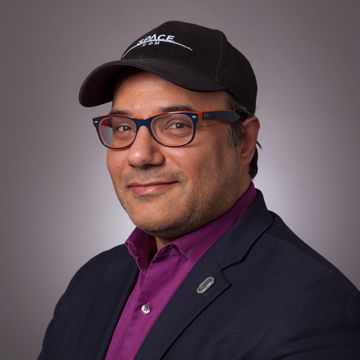
Responsible for Space.com's editorial vision, Tariq Malik has been the Editor-in-Chief of Space.com since 2019 and has covered space news and science for 18 years. He joined the Space.com team in 2001, first as an intern and soon after as a full-time spaceflight reporter covering human spaceflight, exploration, astronomy and the night sky. He became Space.com's managing editor in 2009. As on-air talent has presented space stories on CNN, Fox News, NPR and others.
Tariq is an Eagle Scout (yes, he earned the Space Exploration merit badge), a Space Camp veteran (4 times as a kid, once as an adult), and has taken the ultimate "vomit comet" ride while reporting on zero-gravity fires. Before joining Space.com, he served as a staff reporter for The Los Angeles Times covering city and education beats. He has journalism degrees from the University of Southern California and New York University.
Join our Space Forums to keep talking space on the latest missions, night sky and more! And if you have a news tip, correction or comment, let us know at: [email protected].

Space.com is the premier source of space exploration, innovation and astronomy news, chronicling (and celebrating) humanity's ongoing expansion across the final frontier. Originally founded in 1999, Space.com is, and always has been, the passion of writers and editors who are space fans and also trained journalists. Our current news team consists of Editor-in-Chief Tariq Malik; Editor Hanneke Weitering, Senior Space Writer Mike Wall; Senior Writer Meghan Bartels; Senior Writer Chelsea Gohd, Senior Writer Tereza Pultarova and Staff Writer Alexander Cox, focusing on e-commerce. Senior Producer Steve Spaleta oversees our space videos, with Diana Whitcroft as our Social Media Editor.
Watch the 1st trailer for 'Dune: Prophecy' prequel series (video)
'Fallout' season 2 is going to New Vegas. How might outer space tie in?
'That's part of space exploration': Artemis 2 astronauts unfazed by moon mission delays (exclusive)
Most Popular
- 2 Autel EVO Max 4T drone review
- 3 NASA's Mars sample return mission is in trouble. Could a single SLS megarocket be the answer?
- 4 NASA's Juno probe captures fascinating high-resolution images of Jupiter's icy moon Europa
- 5 Blue Origin will launch these 6 passengers May 19, on its 1st crewed mission since 2022
Restaurant Globus

RESTAURANT GLOBUS, Elektrostal - Restaurant Reviews & Photos - Tripadvisor
Request Medical Records
Online Scheduling
- Contact Us (763) 587-7999

- Family Medicine
- Internal Medicine
- Obstetrics & Gynecology
- Colon & Rectal Surgery
- Rheumatology
- Anticoagulation Clinic
- Bone Density
- Cardiac Care (MHI)
- Cardiac Testing
- COVID-19 Testing
- Dermatology (Mittal)
- DOT Examinations
- Hearing Health Screening
- Lakeland Sleep
- Mammography
- On-Site Lab
- Radiology (X-ray)
- Virtual Voyage Visit
- Walk-In Clinic
- Center for Women's Health
- Maple Grove
- Corporate Office
- Diabetes Education
- Hearing Health
- Patient Forms
- Request Online Medical Records
- Insurance & Payment Options
- Prescription Refills
- Resources & Classes
COVID-19 Vaccine Information Center
Covid-19 vaccination scheduling.
The new 2023-2024 COVID vaccine is recommended for anyone over the age of 6 months old regardless of previous COVID vaccine status.
Voyage Healthcare currently carries the Moderna 2023-2024 vaccine formulation for anyone over the age of 6 months.
- An office visit with your provider, OR
- Schedule a vaccine appointment at one of our clinic locations.
(Please note Voyage Healthcare no longer carries Pfizer 2023-2024 COVID vaccines).
Quick Links
- Voyage Healthcare COVID-19 Resources
- Minnesota Department of Health - Vaccine Basics
- CDC: Clinical Resources for Each COVID-19 Vaccine
- The COVID-19 Vaccine - What You Need to Know
- Ways Voyage Healthcare is Keeping You Safe
- COVID-19 Testing Information
- Coronavirus, Pregnancy, and Breastfeeding
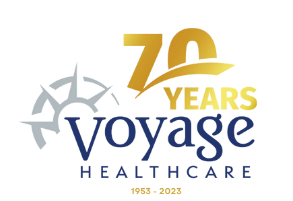
- Address: 9201 West Broadway Avenue North, Brooklyn Park, MN 55445
- Patient Information Center
Subscribe to the Blog
© 2023 Voyage Healthcare

40 Facts About Elektrostal
Written by Lanette Mayes
Modified & Updated: 17 May 2024
Reviewed by Jessica Corbett

Elektrostal is a vibrant city located in the Moscow Oblast region of Russia. With a rich history, stunning architecture, and a thriving community, Elektrostal is a city that has much to offer. Whether you are a history buff, nature enthusiast, or simply curious about different cultures, Elektrostal is sure to captivate you.
This article will provide you with 40 fascinating facts about Elektrostal, giving you a better understanding of why this city is worth exploring. From its origins as an industrial hub to its modern-day charm, we will delve into the various aspects that make Elektrostal a unique and must-visit destination.
So, join us as we uncover the hidden treasures of Elektrostal and discover what makes this city a true gem in the heart of Russia.
Key Takeaways:
- Elektrostal, known as the “Motor City of Russia,” is a vibrant and growing city with a rich industrial history, offering diverse cultural experiences and a strong commitment to environmental sustainability.
- With its convenient location near Moscow, Elektrostal provides a picturesque landscape, vibrant nightlife, and a range of recreational activities, making it an ideal destination for residents and visitors alike.
Known as the “Motor City of Russia.”
Elektrostal, a city located in the Moscow Oblast region of Russia, earned the nickname “Motor City” due to its significant involvement in the automotive industry.
Home to the Elektrostal Metallurgical Plant.
Elektrostal is renowned for its metallurgical plant, which has been producing high-quality steel and alloys since its establishment in 1916.
Boasts a rich industrial heritage.
Elektrostal has a long history of industrial development, contributing to the growth and progress of the region.
Founded in 1916.
The city of Elektrostal was founded in 1916 as a result of the construction of the Elektrostal Metallurgical Plant.
Located approximately 50 kilometers east of Moscow.
Elektrostal is situated in close proximity to the Russian capital, making it easily accessible for both residents and visitors.
Known for its vibrant cultural scene.
Elektrostal is home to several cultural institutions, including museums, theaters, and art galleries that showcase the city’s rich artistic heritage.
A popular destination for nature lovers.
Surrounded by picturesque landscapes and forests, Elektrostal offers ample opportunities for outdoor activities such as hiking, camping, and birdwatching.
Hosts the annual Elektrostal City Day celebrations.
Every year, Elektrostal organizes festive events and activities to celebrate its founding, bringing together residents and visitors in a spirit of unity and joy.
Has a population of approximately 160,000 people.
Elektrostal is home to a diverse and vibrant community of around 160,000 residents, contributing to its dynamic atmosphere.
Boasts excellent education facilities.
The city is known for its well-established educational institutions, providing quality education to students of all ages.
A center for scientific research and innovation.
Elektrostal serves as an important hub for scientific research, particularly in the fields of metallurgy, materials science, and engineering.
Surrounded by picturesque lakes.
The city is blessed with numerous beautiful lakes, offering scenic views and recreational opportunities for locals and visitors alike.
Well-connected transportation system.
Elektrostal benefits from an efficient transportation network, including highways, railways, and public transportation options, ensuring convenient travel within and beyond the city.
Famous for its traditional Russian cuisine.
Food enthusiasts can indulge in authentic Russian dishes at numerous restaurants and cafes scattered throughout Elektrostal.
Home to notable architectural landmarks.
Elektrostal boasts impressive architecture, including the Church of the Transfiguration of the Lord and the Elektrostal Palace of Culture.
Offers a wide range of recreational facilities.
Residents and visitors can enjoy various recreational activities, such as sports complexes, swimming pools, and fitness centers, enhancing the overall quality of life.
Provides a high standard of healthcare.
Elektrostal is equipped with modern medical facilities, ensuring residents have access to quality healthcare services.
Home to the Elektrostal History Museum.
The Elektrostal History Museum showcases the city’s fascinating past through exhibitions and displays.
A hub for sports enthusiasts.
Elektrostal is passionate about sports, with numerous stadiums, arenas, and sports clubs offering opportunities for athletes and spectators.
Celebrates diverse cultural festivals.
Throughout the year, Elektrostal hosts a variety of cultural festivals, celebrating different ethnicities, traditions, and art forms.
Electric power played a significant role in its early development.
Elektrostal owes its name and initial growth to the establishment of electric power stations and the utilization of electricity in the industrial sector.
Boasts a thriving economy.
The city’s strong industrial base, coupled with its strategic location near Moscow, has contributed to Elektrostal’s prosperous economic status.
Houses the Elektrostal Drama Theater.
The Elektrostal Drama Theater is a cultural centerpiece, attracting theater enthusiasts from far and wide.
Popular destination for winter sports.
Elektrostal’s proximity to ski resorts and winter sport facilities makes it a favorite destination for skiing, snowboarding, and other winter activities.
Promotes environmental sustainability.
Elektrostal prioritizes environmental protection and sustainability, implementing initiatives to reduce pollution and preserve natural resources.
Home to renowned educational institutions.
Elektrostal is known for its prestigious schools and universities, offering a wide range of academic programs to students.
Committed to cultural preservation.
The city values its cultural heritage and takes active steps to preserve and promote traditional customs, crafts, and arts.
Hosts an annual International Film Festival.
The Elektrostal International Film Festival attracts filmmakers and cinema enthusiasts from around the world, showcasing a diverse range of films.
Encourages entrepreneurship and innovation.
Elektrostal supports aspiring entrepreneurs and fosters a culture of innovation, providing opportunities for startups and business development.
Offers a range of housing options.
Elektrostal provides diverse housing options, including apartments, houses, and residential complexes, catering to different lifestyles and budgets.
Home to notable sports teams.
Elektrostal is proud of its sports legacy, with several successful sports teams competing at regional and national levels.
Boasts a vibrant nightlife scene.
Residents and visitors can enjoy a lively nightlife in Elektrostal, with numerous bars, clubs, and entertainment venues.
Promotes cultural exchange and international relations.
Elektrostal actively engages in international partnerships, cultural exchanges, and diplomatic collaborations to foster global connections.
Surrounded by beautiful nature reserves.
Nearby nature reserves, such as the Barybino Forest and Luchinskoye Lake, offer opportunities for nature enthusiasts to explore and appreciate the region’s biodiversity.
Commemorates historical events.
The city pays tribute to significant historical events through memorials, monuments, and exhibitions, ensuring the preservation of collective memory.
Promotes sports and youth development.
Elektrostal invests in sports infrastructure and programs to encourage youth participation, health, and physical fitness.
Hosts annual cultural and artistic festivals.
Throughout the year, Elektrostal celebrates its cultural diversity through festivals dedicated to music, dance, art, and theater.
Provides a picturesque landscape for photography enthusiasts.
The city’s scenic beauty, architectural landmarks, and natural surroundings make it a paradise for photographers.
Connects to Moscow via a direct train line.
The convenient train connection between Elektrostal and Moscow makes commuting between the two cities effortless.
A city with a bright future.
Elektrostal continues to grow and develop, aiming to become a model city in terms of infrastructure, sustainability, and quality of life for its residents.
In conclusion, Elektrostal is a fascinating city with a rich history and a vibrant present. From its origins as a center of steel production to its modern-day status as a hub for education and industry, Elektrostal has plenty to offer both residents and visitors. With its beautiful parks, cultural attractions, and proximity to Moscow, there is no shortage of things to see and do in this dynamic city. Whether you’re interested in exploring its historical landmarks, enjoying outdoor activities, or immersing yourself in the local culture, Elektrostal has something for everyone. So, next time you find yourself in the Moscow region, don’t miss the opportunity to discover the hidden gems of Elektrostal.
Q: What is the population of Elektrostal?
A: As of the latest data, the population of Elektrostal is approximately XXXX.
Q: How far is Elektrostal from Moscow?
A: Elektrostal is located approximately XX kilometers away from Moscow.
Q: Are there any famous landmarks in Elektrostal?
A: Yes, Elektrostal is home to several notable landmarks, including XXXX and XXXX.
Q: What industries are prominent in Elektrostal?
A: Elektrostal is known for its steel production industry and is also a center for engineering and manufacturing.
Q: Are there any universities or educational institutions in Elektrostal?
A: Yes, Elektrostal is home to XXXX University and several other educational institutions.
Q: What are some popular outdoor activities in Elektrostal?
A: Elektrostal offers several outdoor activities, such as hiking, cycling, and picnicking in its beautiful parks.
Q: Is Elektrostal well-connected in terms of transportation?
A: Yes, Elektrostal has good transportation links, including trains and buses, making it easily accessible from nearby cities.
Q: Are there any annual events or festivals in Elektrostal?
A: Yes, Elektrostal hosts various events and festivals throughout the year, including XXXX and XXXX.
Elektrostal's fascinating history, vibrant culture, and promising future make it a city worth exploring. For more captivating facts about cities around the world, discover the unique characteristics that define each city . Uncover the hidden gems of Moscow Oblast through our in-depth look at Kolomna. Lastly, dive into the rich industrial heritage of Teesside, a thriving industrial center with its own story to tell.
Was this page helpful?
Our commitment to delivering trustworthy and engaging content is at the heart of what we do. Each fact on our site is contributed by real users like you, bringing a wealth of diverse insights and information. To ensure the highest standards of accuracy and reliability, our dedicated editors meticulously review each submission. This process guarantees that the facts we share are not only fascinating but also credible. Trust in our commitment to quality and authenticity as you explore and learn with us.
Share this Fact:

IMAGES
COMMENTS
Voyage Healthcare now offers online scheduling! SCHEDULE APPOINTMENT. General Information: (763) 587-7999. Lines open Monday - Friday, 7:00 am - 5:00 pm. Colon & Rectal Surgery Appointments: (763) 587-7752. Lines open Monday - Friday,
Members of the Voyager 1 flight team celebrate after receiving health and status data from the spacecraft. Next, engineers need to enable the probe to start sending science data again.
For the first time since November, NASA's Voyager 1 spacecraft is returning usable data about the health and status of its onboard engineering systems.The next step is to enable the spacecraft to begin returning science data again. The probe and its twin, Voyager 2, are the only spacecraft to ever fly in interstellar space (the space between stars).
Members of the Voyager team celebrate at NASA's Jet Propulsion Laboratory after receiving data about the health and status of Voyager 1 for the first time in months. NASA/JPL-Caltech hide caption
Note: Because Earth moves around the sun faster than Voyager 1 is speeding away from the inner solar system, the distance between Earth and the spacecraft actually decreases at certain times of year. Distance from Sun: This is a real-time indicator of Voyagers' straight-line distance from the sun in astronomical units (AU) and either miles (mi ...
Voyager 1's flight data system collects information from the spacecraft's science instruments and bundles it with engineering data that reflects its current health status.
The Voyager 1 probe is the most distant human-made object in existence. ... But what was being relayed back to mission controllers — including science data and information about the health of ...
The PAM Voyages Behavioral Health organization builds upon the history of PAM Health as a respected provider of quality healthcare services by continuing to develop an environment that fosters meaningful behavioral health improvement and recovery. (NAMI.org) The purpose of our "We Care" program is to make sure that we are providing the very ...
CAMBRIDGE, Mass. October 4, 2022 -- Voyager Therapeutics, Inc. (Nasdaq: VYGR), a gene therapy and neuroscience company developing life-changing treatments and next-generation adeno-associated virus (AAV) capsids, today announced that Pfizer, Inc. (NYSE: PFE) has exercised its option to license a novel capsid generated from Voyager's TRACERTM capsid discovery platform to help enable a ...
Sanofi also has backed out of deals with Voyager. Founded in 2014 by Boston venture capital firm Third Rock Ventures, Voyager employs about 180 people in the US, according to its latest annual report.
That's fact alone makes us your unfair advantage in healthcare staffing! You owe it to yourself to experience the Voyage Healthcare difference. Inquire today…we'll be more than glad to have you! Discover Why We're the #1 High-Paying Travel Nurse Agency. 100% 401k Match, Free Day One Insurance, & Industry Leading Pay Rates for RNs.
111 Online First. Available 24 hours a day, every day. If needed, an NHS advisor will help you to be seen quickly and safely. 111.NHS.UK. When the situation is not life threatening and: if you think you need to go to hospital. if you don't know the most suitable place to go or call. if you don't have a GP to call or if your GP Practice is ...
Bathroom Upgrades That Just Make Sense. Your one stop shop for international travel via informative posts and tips for healthy, adventure, luxury, wellness, culinary and sustainable travel as well as vegan recipes, green living and tips featuring videos, weekly articles and more to help you live a happier, healthier greener life! Join me now!
0:45. After weeks of giving Earth the silent treatment, NASA's Voyager 2 spacecraft is once again communicating with mission control from billions of miles away. All it took was for the ground ...
Voyager Therapeutics has dosed the first patient in a Phase Ia single-ascending dose study of its investigational anti-tau antibody VY-TAU01 for patients with Alzheimer's disease. The trial will ...
Voyager 1 has been traveling through space since 1977, and some scientists hoped it could keep sending back science data for 50 years. But a serious glitch has put that milestone in jeopardy.
Voyager anticipates that the data from the SAD trial will inform the design of a Phase 1b multiple ascending dose (MAD) trial in patients with early Alzheimer's disease, which Voyager expects to ...
The voyage of one COPH alumni through public health. Liz Bannon, College of Public Health. May 10, 2024. Alumni & Development. Originally from Puerto Rico, Karen Ruiz-Ayala, a USF College of Public Health alumna, moved to Spring Hill, Fla. when she was young and discovered her passion for public health through reading.
Science Space Animals Health Environment. Voyager 1 was in crisis in interstellar space. NASA wouldn't give up. ... Voyager 2 also flew by Uranus and Neptune and is the only spacecraft to have ...
64 reviews. Location 4.2. Cleanliness 3.5. Service 3.7. Value 3.6. The sanatorium "Valuevo" is a historical health resort located in a unique location of the New Moscow on the territory of 30 hectares of the ancient noble estate of Count Musin-Pushkin with a perfectly preserved architectural ensemble and a landscape park, in an ecologically ...
Comments (0) On Episode 110 of This Week In Space, Rod and Tariq talk with Linda Spilker, Voyager project scientist, about the recent rescue of Voyager 1 from beyond the solar system. The Voyager ...
Review. Share. 67 reviews. #2 of 28 Restaurants in Elektrostal $$ - $$$, European, Contemporary, Vegetarian Friendly. Fryazevskoye Hwy., 14, Elektrostal Russia. + Add phone number + Add website + Add hours Improve this listing. There aren't enough food, service, value or atmosphere ratings for Restaurant Globus yet.
Residents of a Moscow region town impacted by power outages have taken to the streets, demanding that local authorities restore heat to their homes as subzero temperatures grip the region, Russian ...
Schedule a vaccine appointment at one of our clinic locations. (Please note Voyage Healthcare no longer carries Pfizer 2023-2024 COVID vaccines). To schedule an appointment, please schedule online or call at ( 763) 587-7999. Voyage Healthcare is committed to your health and wellness. We know our patients are anxious to receive the COVID-19 vaccine.
40 Facts About Elektrostal. Elektrostal is a vibrant city located in the Moscow Oblast region of Russia. With a rich history, stunning architecture, and a thriving community, Elektrostal is a city that has much to offer. Whether you are a history buff, nature enthusiast, or simply curious about different cultures, Elektrostal is sure to ...